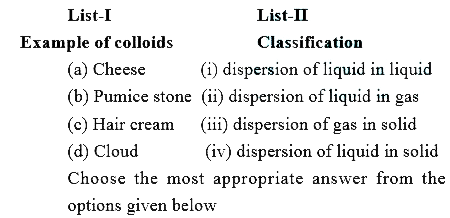Statement I : The ferromagnetic property depends on temperature. At high temperature, ferromagnet becomes paramagnet.
Statement II : At high temperature, the domain wall area of a ferromagnetic substance increases.
In the light of the above statements, choose the most appropriate answer from the options given below :
Statement I is true but Statement II is false
Both Statement I and Statement II are true
Both Statement I and Statement II are false
Statement I is false but Statement II is true
To solve the problem, we need to analyze both statements regarding ferromagnetic materials and their behavior at high temperatures.
1. Understanding Ferromagnetism:
- Ferromagnetic materials have a property where they can become magnetized in the presence of an external magnetic field. This property is due to the alignment of magnetic domains within the material.
2. Effect of Temperature on Ferromagnetism:
- As the temperature increases, the thermal energy causes the magnetic domains to become misaligned. This leads to a decrease in the overall magnetization of the material.
- At sufficiently high temperatures, the thermal agitation overcomes the magnetic interactions, and the material loses its ferromagnetic properties, transitioning to a paramagnetic state.
3. Analyzing Statement I:
- Statement I claims that "the ferromagnetic property depends on temperature. At high temperature, ferromagnet becomes paramagnet."
- This statement is true. As explained, increasing temperature causes the ferromagnetic material to lose its ferromagnetic properties and behave as a paramagnet.
4. Analyzing Statement II:
- Statement II states that "at high temperature, the domain wall area of a ferromagnetic substance increases."
- This statement is false. As the temperature increases, the alignment of domains decreases, leading to a reduction in the effective domain size and thus a decrease in the domain wall area.
5. Conclusion:
- Based on the analysis, Statement I is true and Statement II is false.
Final Answer:
- Statement I is true, Statement II is false.
- Ferromagnetic materials have a property where they can become magnetized in the presence of an external magnetic field. This property is due to the alignment of magnetic domains within the material.
- As the temperature increases, the thermal energy causes the magnetic domains to become misaligned. This leads to a decrease in the overall magnetization of the material.
- At sufficiently high temperatures, the thermal agitation overcomes the magnetic interactions, and the material loses its ferromagnetic properties, transitioning to a paramagnetic state.
- Statement I claims that "the ferromagnetic property depends on temperature. At high temperature, ferromagnet becomes paramagnet."
- This statement is true. As explained, increasing temperature causes the ferromagnetic material to lose its ferromagnetic properties and behave as a paramagnet.
- Statement II states that "at high temperature, the domain wall area of a ferromagnetic substance increases."
- This statement is false. As the temperature increases, the alignment of domains decreases, leading to a reduction in the effective domain size and thus a decrease in the domain wall area.
- Based on the analysis, Statement I is true and Statement II is false.
- Statement I is true, Statement II is false.
Topper's Solved these Questions
- BOOK - JEE MAINS PREVIOUS YEARCHAPTER - JEE MAINS 2021EXERCISE - PHYSICS (SECTION-B)40videos
JEE MAINS 2021
- BOOK - JEE MAINS PREVIOUS YEARCHAPTER - JEE MAINS 2021EXERCISE - PHYSICS (SECTION - A)40videos
JEE MAINS 2021
- BOOK - JEE MAINS PREVIOUS YEARCHAPTER - JEE MAINS 2020EXERCISE - PHYSICS246videos
JEE MAINS 2020
- BOOK - JEE MAINS PREVIOUS YEARCHAPTER - JEE MAINS 2022EXERCISE - PHYSICS (SECTION -B)10videos
JEE MAINS 2022
Similar Questions
Knowledge Check
- Question 1 - Select One
Match List - I with List- II

Choose the most appropriate answer from the options given below -A(a)→(ii),(b)→(iii),(c)→(iv),(d)→(i)B(a)→(i),(b)→(iv),(c)→(iii),(d)→(ii)C(a)→(i),(b)→(iii),(c)→(iv),(d)→(ii)D(a)→(iv),(b)→(i),(c)→(ii),(d)→(iii) - Question 2 - Select One
Match List - I with List- II
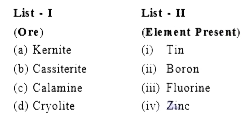
Choose the most appropriate answer from the options given below -A(a)→(i),(b)→(iii),(c)→(iv),(d)→(ii)B(a)→(ii),(b)→(i),(c)→(iv),(d)→(iii)C(a)→(ii),(b)→(iv),(c)→(i),(d)→(iii)D(a)→(iii),(b)→(i),(c)→(ii),(d)→(iv)
Match List-I with List -II
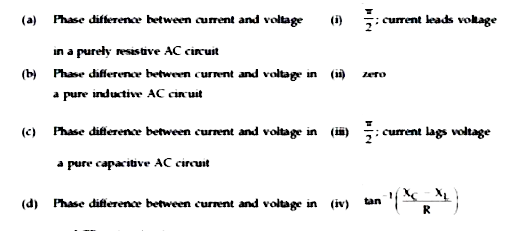
Choose the most appropriate answer from the options given below:View SolutionMatch List-I with List-II :
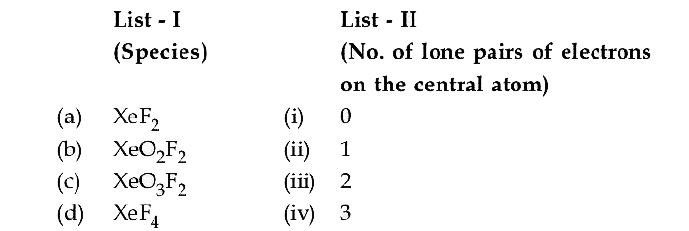
Choose the most appropriate answer from the options given below :View SolutionMatch List-I with List-II :
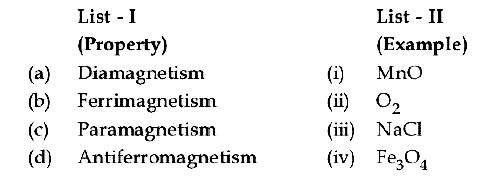
Choose the most appropriate answer from the options given below :View SolutionMatch List -I with List -II :

Choose the most appropriate answer from the options given below :View SolutionMatch List - I with List - II
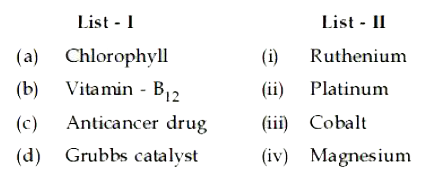
Choose the most appropriate answer from the options given below :View SolutionMatch list - I with List - II :

Choose the most appropriate answer from the options given below :View Solution



